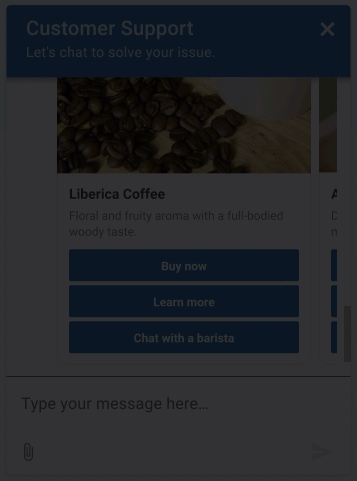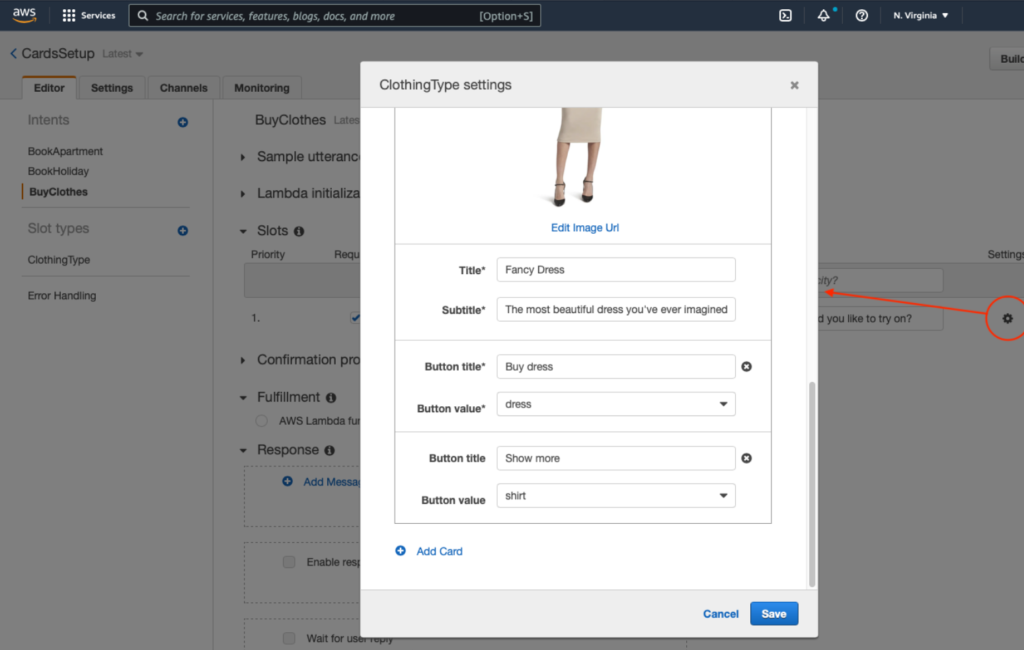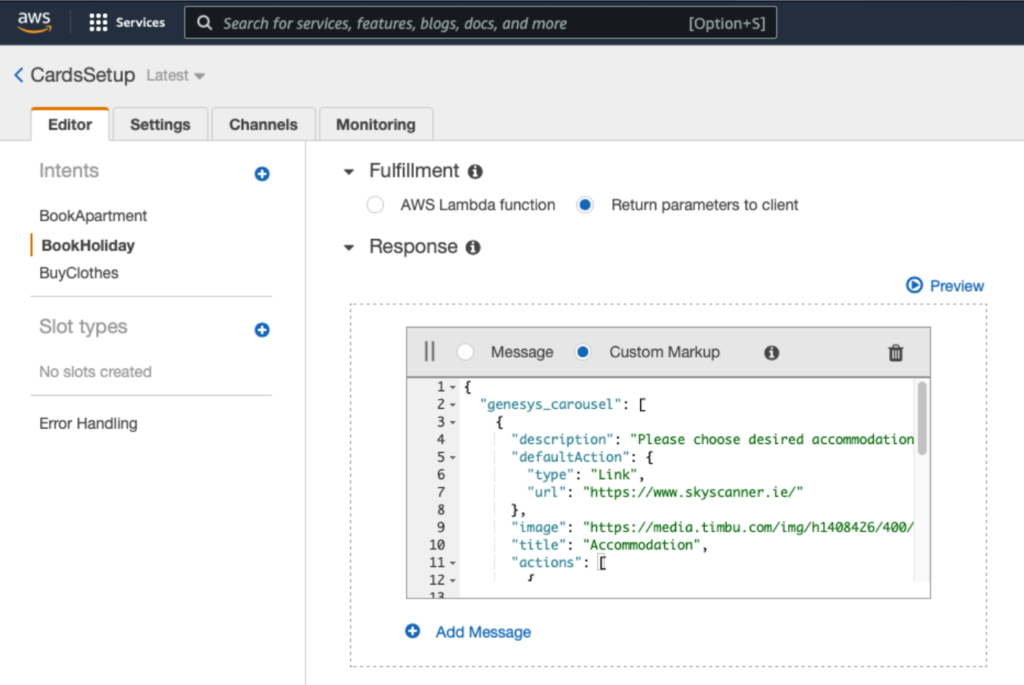Work with carousels in bot conversations
Carousels facilitate bot conversations by providing advanced options and actions with an automated experience. Carousels provide a sophisticated set of options for customers by presenting a series of cards with descriptions, images, titles, texts, and optional referrals to external websites. For more information about cards, see Work with cards in bot conversations.
Example: Carousels in Genesys Web Messenger

Bot and channel support
Currently supported bots:
- Amazon Lex v1
- Google Dialogflow ES
- Google Dialogflow CX
- Bot Connector
Currently supported channels:
- Genesys Web Messenger
- Facebook Messenger
- Instagram (beta)
- Open Messaging
- WhatsApp Messenger
Considerations for carousel implementation
When you design and implement carousel structures in your bot replies, consider these limitations:
- You can implement up to 10 cards in a single carousel.
- The payload that you configure on the buttons in the card structure must be unique across all the cards in the carousel.
- Twitter and WhatsApp do not support carousel structures.
- Amazon Lex V1 limits the custom JSON to 1000 characters. If you must use more than 1000 characters to create your carousel, this limitation can impact the implementation.
- Default actions are not supported for WhatsApp, LINE, or Twitter. If you configure default actions in these applications, then the applications ignore them.
Amazon Lex v1
These sections describe how to incorporate carousels into your Amazon Lex V1 bot, and include use case examples and other resources.
- Install the Amazon Lex integration from Genesys AppFoundry.
- Configure the IAM role with permissions for the Amazon Lex app.
- Configure and activate the Lex integration in Genesys Cloud.
- To set up carousel options in the AWS Lex Console, use this custom JSON to define the cards for your bot’s intent: Note: Amazon Lex V1 limits the JSON length to 1000 characters.
{
"genesys_prompt": "String", // optional message text
"genesys_carousel": [
{
"title": "String", // mandatory text to show in the title
"description": "String", // optional text to show in the description
"image": "URL", // optional URL of an image
"defaultAction": { // optional default button action
"type": "String", // Describes the type of action. Valid values Link Postback
"text": "String", // The response text from the button click
"payload": "String", // Text to be returned as the payload from a ButtonResponse when a button is clicked. The payload and text are a combination which will have to be unique across each card and carousel in order to determine which button was clicked in that card or carousel.
"url": "String" // A URL of a web page to direct the user to.
},
"actions": [
{
"type": "String", // Describes the type of action. Valid values Link Postback
"text": "String", // The response text from the button click
"payload": "String" // Text to be returned as the payload from a ButtonResponse when a button is clicked. The payload and text are a combination which will have to be unique across each card and carousel in order to determine which button was clicked in that card or carousel.
},
{
"type": "String", // Describes the type of action. Valid values Link Postback
"text": "String", // The response text from the button click
"url": "String" // A URL of a web page to direct the user to.
}
]
}
]
}
Learn more:
- About the Amazon Lex integration
- Using a Response Card in the AWS Developer Guide
- Response Cards in the Managing Messages page of the AWS Developers Guide
Google Dialogflow ES and CX
These sections describe how to incorporate carousels into your Google Dialogflow ES or CX bot, and include use case examples and other resources.
- Install the Google Dialogflow integration from Genesys AppFoundry.
- Configure the Google Dialogflow platform service account credential.
- Enable the Google Dialogflow integration.
- To set up carousels in the Dialogflow console, use this custom JSON to define card options for your bot’s intent. Use multiple card structures to create a carousel.
{
"genesys_prompt": "String", // optional message text
"genesys_carousel": [
{
"title": "String", // mandatory text to show in the title
"description": "String", // optional text to show in the description
"image": "URL", // optional URL of an image
"defaultAction": { // optional default button action
"type": "String", // Describes the type of action. Valid values Link Postback
"text": "String", // The response text from the button click
"payload": "String", // Text to be returned as the payload from a ButtonResponse when a button is clicked. The payload and text are a combination which will have to be unique across each card and carousel in order to determine which button was clicked in that card or carousel.
"url": "String" // A URL of a web page to direct the user to.
},
"actions": [
{
"type": "String", // Describes the type of action. Valid values Link Postback
"text": "String", // The response text from the button click
"payload": "String" // Text to be returned as the payload from a ButtonResponse when a button is clicked. The payload and text are a combination which will have to be unique across each card and carousel in order to determine which button was clicked in that card or carousel.
},
{
"type": "String", // Describes the type of action. Valid values Link Postback
"text": "String", // The response text from the button click
"url": "String" // A URL of a web page to direct the user to.
}
]
}
]
}
To use the carousel options to fill your bot’s slot, use the custom JSON from the previous section into a webhook. Use multiple card structures to create a carousel. You can also use an AWS lambda for this purpose. For more information, see Webhook for slot filling in the Google Cloud Dialogflow ES guide.
Learn more:
- About the Google Dialogflow integration
- Webhook for slot filling in the Google Cloud Dialogflow ES guide
Bot Connector
These sections describe how to incorporate carousels into your Genesys Bot Connector bot, and include other resources.




